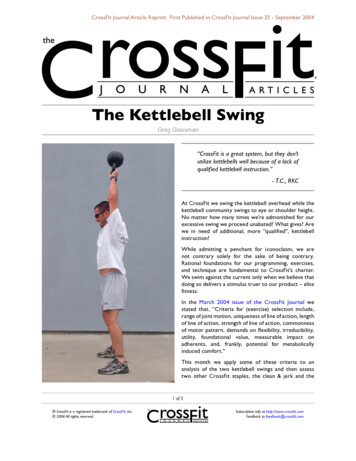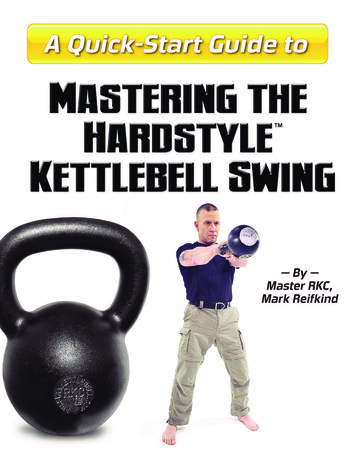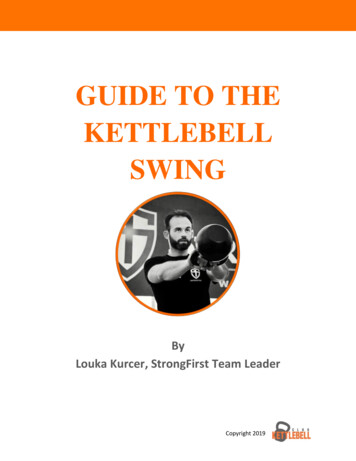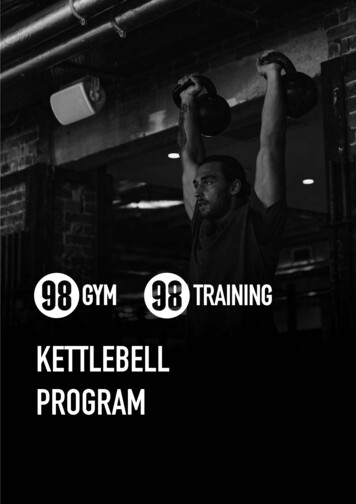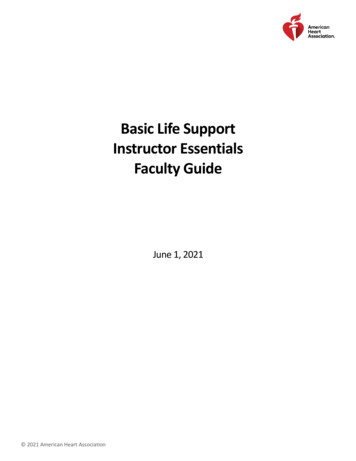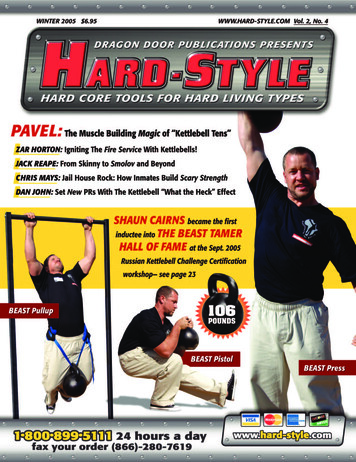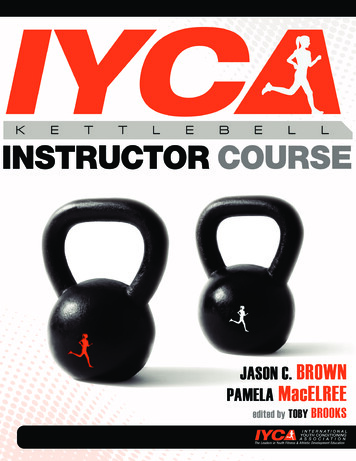
Transcription
KETTLEBELL INSTRUCTOR COURSE 1
2 INTERNATIONAL YOUTH CONDITIONING ASSOCIATIONKettlebell Instructor Course 2011, International Youth Conditioning AssociationPO Box 1539Elizabethtown, KY 42702888.785.0422All rights reservedKettlebell Instructor Course is published by the InternationalYouth Conditioning Association. ALL RIGHTS RESERVED. Nopart of this publication may be reproduced, stored or transmittedin any form, for any reason or by any means, whether re-drawn,enlarged or otherwise altered including mechanical, photocopy,digital storage & retrieval or otherwise, without the prior permission in writing from both the copyright owner and the publisher.The text, layout and designs presented in this book, as well asthe book in its entirety, are protected by the copyright laws of theUnited States (17 U.S.C. 101 et seq.) and similar laws in othercountries.Scanning, uploading and/or distribution of this book, or any designs or photographs contained herein, in whole or part (whetherre-drawn, re- photographed or otherwise altered) via the Internet,CD, DVD, E-zine, photocopied hand-outs, or any other means(whether offered for free or for a fee) without the expressed written permission from both the copyright owner and the publisher isillegal and punishable by law.The copyright owner and publisher of this book appreciate yourhonesty and integrity and ask that you do not participate in or encourage piracy of copyrighted material. Be sure to purchase (ordownload) only authorized material.
KETTLEBELL INSTRUCTOR COURSE 3TAB LE O F C O N T E N T S1. Ke ttlebell Basics.52. Ke ttlebell Saf e ty.93. Benefits of Ke ttlebell Training.134. Scientif ic Foundations. .175. Biomo tor Development.226. Mo tor Skill Acquisition.257. Pr ogram Design Model.298. IYCA Ke ttlebell Training Templates.329 . C omp lexe s & Cir cuits . . . . . . . 3510. Team Tr aining.39
4 INTERNATIONAL YOUTH CONDITIONING ASSOCIATION
KE TT L E BEL L B A SIC SKETTLEBELL INSTRUCTOR COURSE 51
6 INTERNATIONAL YOUTH CONDITIONING ASSOCIATIONIN TR ODUCT IONThe kettlebell has been used as a powerful tool for developing fun, functionaland dynamic training and conditioningprograms for decades. The purposeof this course is to provide personalized instruction, verbal, and visual teaching cues as well aspartner exercises to maximize safety and promote high quality movement and instruction.This course will also include extensivehands-on instructional examples to further solidify the fitness professionals’ ability to both fully understand and effectively implement kettlebell training methodology in a broader schemeof program design.O BJEC T IVESThe primary objective of this course isto ensure that the fitness professionallearns, understands, demonstratesand can implement safe and effectivekettlebell training methodology and techniques.Additionally, individuals who complete thecourse should be able to explain and demonstrate each exercise with accuracy and precision. The fitness professional should be ableto exhibit a comprehensive understanding ofthe scientific underpinnings of the program andapply such information meaningfully in a teaching/coaching and learning environment.This manual is intended to provide the fitness professional with a thorough understanding of the scientific theory grounded in contemporary exercise science, biomechanicsand functional anatomy upon which modernkettlebell training programming should be built.Furthermore, comprehensive exercise illustrations, descriptions, and performance tips havealso been provided to maximize the effectiveness and safety of each drill.
KETTLEBELL INSTRUCTOR COURSE 7TH E H IS T OR Y O F KE T T L E B E L L SThe kettlebell has roots in the marketsand fairs of the ancient world, whereiron balls, many of them quite heavy,were used as standard weights.Strongmen would display their prowess byplaying games or performing an array of stuntswith these precursors to what is now commonlyreferred to as a kettlebell.The historical record details the emergenceof strongmen in Europe as early as the sixteenth century, with the iron ball lift included inthe repertoire of strength feats.However, it was in Czarist Russia that theseiron spheres would eventually begin to be regarded for their true utility in the acquisition ofstrength and endurance. Now complete with acast handle, the kettlebell or “girya” became acentral tool for most any Russian strongman.Indeed, according to Pavel Tsatsouline, a leading proponent of kettlebell training in the UnitedStates, the terms “strongman” and “girevik” or“kettlebell man” were synonymous.By the end of the Czarist era, it was conventional wisdom that kettlebell training or “girevoy sport” was a singular method for achieving overall physical development and muscularstrength (Chaplinski, 1913). This assertion waslater verified by two scientific studies: the first(Voropayev 1) proving the systemic benefits ofkettlebell repetitions –gireviks are better prepared to face challenges across a wide rangeof athletics situations; the second (Vinogradov& Lukyanov 2) showing that kettlebell trainingimproves balance, endurance and strength.This would not have surprised men like IvanPiddubny, “The Ukrainian Hercules.” Beginninghis wrestling career at the turn of the century,this once world-famous and undefeated champion used his kettlebell-derived stamina andmight to subjugate all of his opponents for fortyyears.Following Piddubny and other elite athletes,generations of Soviet (and now former Soviet)competitors have embraced the conditioningpower of their beloved girya. Not surprisingly,the Soviet military followed suit.In America, kettlebells have been aroundsince the nineteenth century, perhaps earlier.Like the nameless gireviks who immigrated tothis country in the 1800s, Arthur Saxon (born
8 INTERNATIONAL YOUTH CONDITIONING ASSOCIATIONHenning) carried his knowledge the kettlebell from his native Europe, harnessing its potency into a career that included severalweightlifting records. Early in the twentieth century, hearkeningback to those ancient fairs and markets, Charles MacMahon’sFeats of Strength and Dexterity (1927) included a section on juggling kettlebells.Despite its effectiveness, this rugged old tool could not thrivein an America always in search of the novel or new, and a fitnessindustry increasingly eager to fulfill that desire.For the greater partof the twentieth century, the girya, a staple in Soviet gyms waslost to Americans. That is until now. There is currently a growing movement to reassess the natural health claims and crudefitness tools received from our ancestors. Everything old is newagain. And at the start of the twenty-first century the newest wayto achieve a superior conditioning is to use the ancient kettlebell.
KE T T LE BEL L S A F ET YKETTLEBELL INSTRUCTOR COURSE 92MIKE DAVIS, DPT, ART
10 INTERNATIONAL YOUTH CONDITIONING ASSOCIATIONG EN ERA L G UIDE L I N E S F O R S AF E T Y,IN JU R Y PREVENT I O N & PR O G R AMEFFIC I ENCY W IT H KE T T L E B E L LTRAIN I NGParticipation in most sporting events and/or recreational activities has its inherent risks. The key in minimizing theserisks lies in the comprehension of theactivity. Olympic lifting and free-weight traininghave often been maligned as potentially dangerous, particularly for a developing young athlete. The same holds true for kettlebell training.However, such notions are not based in fact, asparticipation in most team sports exposes theathlete to a higher risk of injury than resistancetraining performed under the supervision of aqualified and competent coach.The following list is comprised of generalguidelines that should be used when introducing an athlete to any new training and conditioning mode, including kettlebell training. Always provide a complete explanationof potential risks and active steps takento minimize their impact. Get medical clearance for those withexisting conditions such as orthopedicinjuries, cardiopulmonary pathologies,cardiovascular pathologies, etc. Make expectations clear up front. Thiscould include specific instructions suchas being on time, being attentive, wearing proper attire, being respectful, working hard, being diligent in time awayfrom the training facility, reporting all injuries/aches & pains, and being honestabout the athlete’s responsibility in thetraining process. This is very importantas it will set the tone for the relationshipbetween the fitness professional andthe athlete. Ensure that the environment is appropriate for the training modality. Kettlebells require approximately at least a 5’x 5’ foot area for ballistic lifts such asswings and snatches should the athleteneed to release the kettlebell. In addition, a resilient floor is recommendedto absorb the pounding that comes withkettlebell training. Ensure that the program follows thebuilding blocks of functionally efficientmovement. One must be able to correctly perform a bodyweight squat before being expected to execute a kettlebell swing, just as one should be ableto perform an efficient high-pull beforebeing taught to snatch. Remember aswith Olympic lifts, dynamic kettlebelllifts require a degree of skill that mustbe taught in a manner appropriate foreach individual. ALWAYS stress quality over quantity.Most of the injuries acquired duringtraining are because of dysfunctional movement and/or tissue overload.Never allow the athlete to repetitivelyperform an exercise with poor form as itwill result in a dysfunctional movement
KETTLEBELL INSTRUCTOR COURSE 11pattern and tissue overload. The sameis true for using a kettlebell that is tooheavy. Instruct athletes to always be mostconcerned with personal safety ratherthan equipment preservation. Athletesshould be taught to safely and effectively release any external load such as akettlebell in the event that control of theimplement is lost. Be sure to begin sessions with a properwarm-up/movement prep module andend with cool-down/stretching program.While infrequent, injuries are sometimesa part of training and the fitness professionalmust know the appropriate steps to take prevent and on occasion manage such injuries.Any health and fitness professional shouldhave a current CPR certification. It is important to understand that unless one is qualified,the urge to treat an injury should be avoidedand instead referred to more qualified personnel. One of the best ways to prevent injuriesis to implement programs that reflect balanceddevelopment, as that is the essence of programdesign. There are many “kettlebell exercises”that address many muscle groups by virtue oftheir multi-joint, multi-planar movements. Forexample, the “windmill” utilizes muscles of thehips, trunk, back, shoulder girdle, chest, andarm in unison.The center of mass in a kettlebell falls awayfrom the handle, resulting in additional rotational torque not normally felt with “traditional”training modalities such as barbells and dumbbells. Because of this added dimension, it isnecessary to evaluate the participant’s ability tocontrol this rotational torque. A lack of controlwill likely result in faulty movement patterns andpredispose the athlete to a cumulative traumainjury over time.Another component of balance involvesflexibility and tissue mobility. Whenever pos-sible, the fitness professional must make surethat exercises are performed within an appropriate range of motion. Exercises performedin a shortened range result in inappropriatemuscular accommodation and will most likelynegatively influence normal range of motion atthat joint and potentially other joints in the kinetic chain. Conversely, exercises performedin an excessive range predispose the connective tissue to injury while also compromising theforce production capacity of the muscles dueto excessive lengthening and inadequate crossbridge articulation. A basic flexibility and softtissue management program should be implemented with any resistance training program.Despite a well balanced training and conditioning program, even a well-trained athletemay still be injured due to participation in sport.While rest and ice are common initial treatmenttechniques for most any soft tissue and/or orthopedic injuries, it may be necessary to contact emergency medical personnel or refer theathlete to an athletic trainer or physical therapist for evaluation. With experience, one willdevelop the skilled sense of when to encouragean athlete to continue (i.e. - momentary musclefatigue) or to discontinue (i.e. – muscle strain)and advise medical attention. When in doubt,ALWAYS err on the side of safety for the athleteand never push to continue unless no doubtabout the severity of the issue exists.Following the instructions depicted in thismanual in addition to the above noted guidelines will greatly reduce the chance of injury tothe athlete.
12 INTERNATIONAL YOUTH CONDITIONING ASSOCIATION
BE N EF I T S OFKE T TL E BEL L T RAIN IN GKETTLEBELL INSTRUCTOR COURSE 133
14 INTERNATIONAL YOUTH CONDITIONING ASSOCIATIONP R OPOSED BEN E F I T S O FKE TTLEBEL L T RAI N I N GThe effectiveness of kettlebell training has been widely debated and thesubject of considerable disagreementamong fitness professionals. Kettlebell proponents cite a number of potential advantages of the kettlebell over alternative resistance implements. Kettlebell training produces strength atextreme ranges of motion. Many typicalkettlebell movement complexes requiremovement through a greater range ofmotion than more isolative traditionalresistance exercises. Additionally, theexplosive nature of most of these complexes is more likely to elicit a stretchreflex, thereby potentially increasingthe athlete’s ability to generate forceand power. Kettlebell training exposes weaknessesand can be used to effectively addressmuscular imbalances. Since kettlebelltraining movement complexes are typically performed unilaterally, it is likelythat deficiencies and imbalances willbecome readily apparent during exercise performance. Weaknesses suchas unilateral grip endurance deficitsor limitations in shoulder strength andrange of motion are commonly notedduring the initial stages of kettlebelltraining implementation. As such, onceidentified, such deficiencies can beeffectively addressed through subsequent training sessions. Kettlebell training creates strong yetflexible joint structures. Kettlebell training complexes increase the demand fordynamic joint stabilization, which canlead to positive adaptations over timethat can potentially reduce the risk ofinjury and accommodate more efficientforce production. The relatively unfamiliar offset center of mass of a kettlebell can trigger new and unique musclerecruitment and proprioceptive inputpatterns relative to more traditional resistance implements. Kettlebells provide considerable flexibility and endless exercise variationswith just one tool. Simply by changingthe grip or repositioning the kettlebellcarriage during movement, the entirefeel and complexity of the movementcan be altered and progressed. Thisfeature alone makes kettlebell trainingparticularly well-suited to a small groupor class setting that requires a wide variety of difficulty depending upon thestrength and abilities of the class participants. Kettlebell training complexes are effective in teaching the athlete to bothabsorb and redirect force system-wide.Since most kettlebell training complexes are multi-joint in nature, the athleteis exposed to force application over thegreatest range of motion possible usingas many joints as possible. This forceapplication has excellent carryover andapplication to a sport environment inwhich forces of unpredictable magnitude and direction from opponents, theplaying surface, and even sporting implements must be effectively managedto maintain balance and produce optimal reaction forces.
KETTLEBELL INSTRUCTOR COURSE 15 Kettlebell training complexes can amplifypower output. Kettlebell training complexes are most often performed rapidly orexplosively. Additionally, the production ofpowerful movements over an extended period of time, or power-endurance, is mosttypical of kettlebell training. This differsfrom more traditional training methods involving strength-endurance in which forcerather than power is produced over time.Power-endurance emphasizes the explosiveness and the minimization of timerequired to produce peakforce, thereby making kettlebell training complexesmore representative of mostsporting situations where itis the ability toproduce powerrather than forcethat typically determines the victor in agiven situation. Kettlebelltrainingmaximizes proprioception and requiresthe athlete to contend with a constantly changing center ofKettlebell training builds powerfulforearms and a strong grip.mass. Since the kettlebell’s centerof gravity lies outside the grip, it canbetter replicates the unpredictableforces and loading patterns typicallyencountered in athletic participation.This unique feature of the kettlebellwill help reinforce this aspect of sportsperformance.
16 INTERNATIONAL YOUTH CONDITIONING ASSOCIATION Kettlebell training builds powerful forearms and a stronggrip. Kettlebells possess a thicker handle than their barbelland dumbbell counterparts, taxing grip and encouraging thedevelopment of greater forearm strength. Furthermore, thesmooth cast iron construction of most kettlebells requires afirmer grip than the high friction knurled grip used in mostdumbbells and barbells. Kettlebell training complexes most often elicit an excellentcardio–respiratory training response. Kettlebell trainingcomplexes often involve the entire body in a significant expenditure of energy to produce explosive movement. Whendesigned with appropriate work to rest intervals, such totalbody training can expose the athlete to a concurrent conditioning effect that stimulates positive neuromuscular as wellas cardiorespiratory adaptations. Kettlebell training eliminates the need for a large trainingfacility. Kettlebells possess a very small footprint, meaning that they take up very little floor space. Kettlebells donot require expensive racks and can easily and safely bestored in a corner or underneath other equipment. Kettlebell training can be very time efficient. Due to thetotal body nature of most kettlebell training complexes, theathlete can undergo a significant training stimulus to themusculoskeletal system throughout the entire body afterjust a few rounds of a few basic movement patterns. Byeliminating non-functional and time consuming isolativemovements, kettlebell training complexes provide significant system-wide training stimulus in a minimal amount oftime.Clearly, kettlebell training complexes can provide a number ofunique and positive advantages over more traditional resistanceimplements including dumbbells and barbells. As such, kettlebelltraining can be an invaluable training tool to enhance overall program effectiveness, athlete interest and motivation, and ultimatelyresultant athletic success.
SC I E N T IF ICF O UND AT IO N SKETTLEBELL INSTRUCTOR COURSE 174
18 INTERNATIONAL YOUTH CONDITIONING ASSOCIATIONS C IEN T IF IC F OUN D AT I O N S O FKETTLEBEL L T RAI N I N GThe competent and skilled fitnessprofessional should not only be concerned with exercise technique butalso the influence of each exerciseon posture, alignment, body mechanics andthe associated musculature. Regardless ofthe specific goals of training, a number of fundamental principles will influence each training session and are applicable to virtually anytraining goal. The following fundamentals arefoundational concepts critical to developing theknowledge, skill and ability to develop safe andeffective training programs.Anatomy: The study of structure.Physiology: The study of function.MovementsThere are six primary movements that can occur around a joint structure. These are flexion,extension, abduction, adduction, rotation andcircumduction. Flexion: A decrease in the angle between two body segments. Extension is an increase in the anglebetween two body segments. Abduction: The movement of a bodysegment away from the midline of thebody. Adduction: The movement of a bodysegment towards the midline of thebody. Rotation: Circular movement of a bodysegment around an axis. Circumduction: A combination ofmovements in which the individual circumscribes shape of geometric conewith the involved extremity.Planes of MotionThere are three imaginary lines that passthrough the human body that are useful in further defining the specific nature and directionof a given movement or series of movements. Sagittal: The vertical plane that dividesthe body into left and right portions.Anterior/posterior movements such asknee flexion and extension occur primarily in the sagittal plane. Frontal: The vertical plane that dividesthe body into anterior and posteriorportions. Lateral movements such asshoulder abduction and adduction occur primarily in the frontal plane. Transverse: The horizontal plane thatdivides the body into upper and lowerportions. Rotary movements such aship internal and external rotation occurprimarily in the transverse plane.Roles of MusculatureAny one muscle can perform several tasks.This task can differ according to which jointthat particular muscle is working around. Eachmuscle may act as an agonist, antagonist, stabilizer, and synergist and as a neutralizer. Agonist: The muscle that produces themost force to move a body segment;the prime mover. Antagonist: The muscle that acts in direct opposition to the agonist or primemover. Synergist: A muscle that assists theagonist in producing movement. Stabilizer: A muscle that supports ajoint or the body while the agonist andsynergists generate movement.
KETTLEBELL INSTRUCTOR COURSE 19 Neutralizer: A muscle that cancels outor otherwise counteracts unwanted orunnecessarymotion.Biomechanics:the study of the physical influences thatgovern human movement. Kinesiology: The study of humanmovement from an anatomical and/ormechanical perspective. Center of gravity: The point at whichall the body’s mass seems to be concentrated; the balance point of a body;the point around which the sum of thetorque’s segmental weights is equal tozero. Force: The energy expended to changethe state of motion of a body. The influence of any force is determined bythe magnitude or size, the direction, thepoint of application, and the line of action. Direction of force: The path alongwhich force is applied. Point of force application: The specific location where force is introducedto the body or system receiving it. Line of action: A straight line throughthe point of application extending indefinitely along the direction of force.Force can either be internal or external. Internal force is produced by a concentric contraction of skeletal muscle, while external forceis introduced by gravity or some other objectapplying force from outside the body to elicitmovement.Newton’s Laws of Motion Newton’s First Law, The Law of Inertia: A body will remain at rest or in motion until acted upon from some outsideforce. A heavier object requires moreforce to overcome inertia and set thebody in motion. A heavier object alsorequires more force to stop or alter motion. Newton’s Second Law, the Law ofAcceleration: Force is the product ofmass and acceleration. Acceleration isproportional to the force acting upon onthe body and is in the same direction asthat force. Newton’s Third Law, The Law of Action-Reaction: For every action, thereis an opposite and equal reaction.Motions utilized in kettlebell training complexes can take multiple forms, including: Linear motion: A body translating andmoving in a straight-line with the changein position occurring relative to one ormore reference points. Linear motionoccurring in a straight line is also sometimes referred to as rectilinear motion. Curvilinear motion: Motion occurringalong a curved path.Laws of LeversA lever is most simply defined as a rigid objectabout which forces are applied at a minimumof two other. The fulcrum or axis serves as thepivot point within that lever system. Two forcesact within a lever system, including the effortforce and the load or resistance force. Effort force (E): Force used to opposethe resistance force. Load (L): Force produced by an objectthat one is trying to move or oppose. Effort arm (EA): Distance along the lever from the point of application of theeffort force to the fulcrum. Resistance arm (RA): Distance alongthe lever from the point of application ofresistance force to the fulcrum. Moment arm of effort (MAE): The perpendicular distance from the effort forceline to the fulcrum. Moment arm of resistance (MAR): Theperpendicular distance from the resistance force line to the fulcrum.
20 INTERNATIONAL YOUTH CONDITIONING ASSOCIATIONHow Levers WorkLevers rotate from the application of force. Thisrotation is influenced by the amount of force,the direction of force and the location along thelever where that force is being applied. To adequately describe a force, all three componentsmust be characterized.There are three classes of levers: First class lever: A lever that has the fulcrum between the resistance force andthe effort force. A see saw is a common example. Relatively rare withinthe body, the cervical extensors utilizea first class lever system to extend thehead. Second class lever: A lever that has itsload positioned between the effort forceand the fulcrum. A wheelbarrow is acommon example. Within the body, thegastrocnemius/soleus complex utilizesa second class lever system to performa heel raise.Second Class LeverFirst Class Lever Third class lever: A lever that has its effort force situated between the load andthe fulcrum. Third class levers are themost common in the human body andthe biceps brachii is a common example when producing elbow flexion.Third Class Lever
KETTLEBELL INSTRUCTOR COURSE 21The rotational result of force is known astorque. Torque is the product of force and distance. The amount of torque is determined bytwo factors: the amount of force and the perpendicular distance from that force to the fulcrum.Effort Torque-TE E x MAEResistance Torque – TR Rx MARKettlebells & BiomechanicsUnderstanding torque is essential in kettlebelltraining since the kettlebell allows for rotationaround the wrist. This rotation around the wristincreases torque elicits additional proprioceptive input, increased motor control and motorunit recruitment and increased intramuscularcoordination.Since the kettlebell extends away from theathlete’s grip, an elongated moment arm of resistance is introduced. Since resultant torque isthe product of resistance and the length of themoment arm of resistance, additional torque isconsequently introduced into the musculoskeletal lever system, as well.Interestingly, this additional torque is notexperienced only at the wrist. Instead, increased torque is similarly introduced proximally up the kinetic chain, manifesting at the elbowand shoulder and elbow. Functionally, this increased torque could potentially be responsiblefor enhancing recruitment and activation withinthe dynamic stabilizers within the entire kineticchain. This can lead to improved performanceacross a broad range of activities from dailychores to top-level athletic competition, not tomention a leaner, stronger, and more injury resistant body.
B I OM O T ORD E V EL OP MEN T22 INTERNATIONAL YOUTH CONDITIONING ASSOCIATION5
KETTLEBELL INSTRUCTOR COURSE 23B IO MO T OR SKI L L D E V E L O PM E N TAs a fitness professional, it is oftennecessary to help athletes achievenumerous and diverse goals. Someathletes want to get stronger. Somewant to be more explosive on the court or thefield. Still others simply want to look and feelbetter and develop some measure of baselinefitness. The relative success of any programis entirely dependent upon the developed exercise prescription presumably built aroundthose goals. However, before prescribing anyspecific program, particularly for the developing athlete, it is essential that the fitness professional possess a thorough understanding ofthe nature and optimization of the fundamentalbio-motor abilities.StrengthStrength is most simply defined as the abilityof the neuromuscular system to produce force.Several factors may influence strength, including: Structural /anatomical factors Physiological/biomechanical factors Psycho-neural/psycho-social factors External/environmental factorsAll other bio-motor skills are dependentupon strength. If the neuromuscular system isunable to produce force, no other expression ofhuman movement is possible such as power,endurance or power-endurance.Strength is best developed through the useof low repetitions, namely 1-5 repetitions perset using a weight that is 80-95% of the 1 repetition maximum. For younger athletes, suchhigh loads should be reduced but high intensityremains a key to positive strength adaptation.The number of sets can vary and can be quitehigh, even as high as 10 sets per movement.Longer rest periods of 2-3 minutes are recommended to improve strength. A very commonset/rep scheme to improve strength is 3-5 setsof 3-5 reps with 3-5 minutes rest between eachset. One popular group of kettlebell exercisesfor strength development strength are known as“grinds.” Grinds are relatively slow, controlledvariants of fundamental movements such asdeadlifts, overhead presses and front squats.PowerPower is the rate at which work is performed,or work/time. Power is simply the combination of strength and speed. Kettlebell trainingis ideal for the development of p
Indeed, according to Pavel Tsatsouline, a lead - ing proponent of kettlebell training in the United States, the terms “strongman” and “girevik” or “kettlebell man” were synonymous. By the end of the Czarist era, it was conven - tional wisdom that kettlebell train

